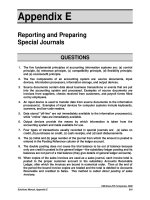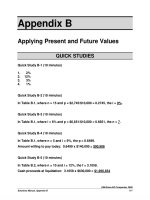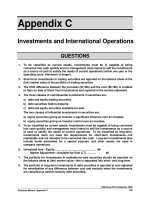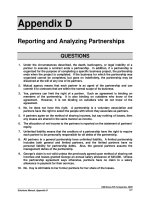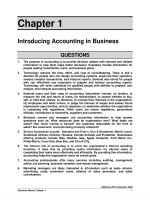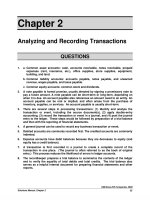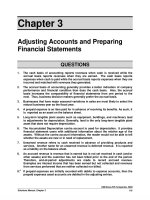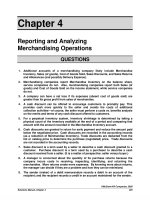Solution manual financial accounting 4e by wild appendix d
Bạn đang xem bản rút gọn của tài liệu. Xem và tải ngay bản đầy đủ của tài liệu tại đây (1.31 MB, 41 trang )
To download more slides, ebook, solutions and test bank, visit
Appendix D
Reporting and Analyzing Partnerships
QUESTIONS
1.
Under the circumstances described, the death, bankruptcy, or legal inability of a
partner to execute a contract ends a partnership. In addition, if a partnership is
organized for the purpose of completing a specific business project, the partnership
ends when the project is completed. If the business for which the partnership was
organized cannot be completed, but goes on indefinitely, the partnership may be
dissolved at the will of any one of its partners.
2.
Mutual agency means that each partner is an agent of the partnership and can
commit it to contracts that are within the normal scope of its business.
3.
Yes, partners can limit the right of a partner. Such an agreement is binding on
members of the partnership. It is also binding on outsiders who know of the
agreement. However, it is not binding on outsiders who do not know of the
agreement.
4.
No, he does not have this right. A partnership is a voluntary association and
partners have the right to select the people with whom they associate as partners.
5.
If partners agree on the method of sharing incomes, but say nothing of losses, then
any losses are shared in the same manner as income.
6.
The allocation of net income to the partners is reported on the statement of partners'
equity.
7.
Unlimited liability means that the creditors of a partnership have the right to require
each partner to be personally responsible for all debts of the partnership.
8.
All partners in a general partnership have unlimited liability. A limited partnership
includes both general and limited partners, and the limited partners have no
personal liability for partnership debts. Also, the general partners assume the
management duties of the partnership.
9.
George's claim is not valid unless the previously agreed upon method of sharing net
incomes and losses granted George an annual salary allowance of $25,000. Unless
the partnership agreement says otherwise, partners have no claim to a salary
allowance in payment for their services.
10. No. Kay is still liable to her former partners for her share of the losses.
©McGraw-Hill Companies, 2008
Solutions Manual, Appendix D
777
To download more slides, ebook, solutions and test bank, visit
11. At all times in the accounting history of a partnership (or any organization), assets
must equal liabilities plus equity. When the assets are converted to cash, any gains
or losses are allocated to the capital accounts of the partners; and when creditors'
claims are paid, assets and liabilities are reduced by equal amounts. Therefore,
when the remaining assets are in the form of cash, the amount of cash must equal
the claims (equity) of the partners.
12. The remaining partners should share the decline in their equities in accordance with
their income-and-loss-sharing ratio.
QUICK STUDIES
Quick Study D-1 (10 minutes)
a. The partnership will need to pay because it is a merchandising firm.
That is, if the vendor knows nothing to the contrary, the vendor can
assume that Leon has the right, because of mutual agency, to bind the
firm to contracts for the purchase of merchandise.
b. A public accounting firm is not in the merchandising business.
Consequently, because the purchase of merchandise to be sold is not
within the normal scope of the business of this firm, the vendor has no
right to assume Leon is acting as the agent for the partnership. Hence,
the partnership probably will not have to pay.
Quick Study D-2 (15 minutes)
Stolton
Net income.............................................
Salary allowances
Stolton ................................................. $15,000
Bright ...................................................
Total salary allowances .....................
Balance of income ................................
Balance allocated equally
Stolton .................................................
8,500
Bright ...................................................
Total allocated equally .......................
Balance of income ................................ ______
Shares of the partners .......................... $23,500
Bright
Total
52,000
$20,000
35,000
17,000
8,500
______
$28,500
17,000
$
0
©McGraw-Hill Companies, 2008
778
Financial Accounting, 4th Edition
To download more slides, ebook, solutions and test bank, visit
Quick Study D-3 (10 minutes)
If Blake is allocated a $100,000 salary allowance and there remains $4,000
to be divided equally, giving Matthai $2,000, then this shows that the
partnership must have earned net income of $104,000.
Quick Study D-4 (10 minutes)
Since Mourlan is a limited partner, he is not personally liable for any unpaid
debts of the partnership. Therefore, the partnership’s creditors cannot
pursue Mourlan’s personal assets.
Quick Study D-5 (10 minutes)
Choi, Capital .............................................................................. 10,000
Amal, Capital ............................................................................. 10,000
Stein, Capital ........................................................................
20,000
To record admission of Stein by purchase.
Quick Study D-6 (10 minutes)
Cash ........................................................................................... 40,000
Kwon, Capital .......................................................................
40,000
To record admission of Kwon.
Quick Study D-7 (15 minutes)
Total partnership return on equity
= Net Income/Average equity
= $25,000 / ($150,000 + $200,000)/2
= $25,000 / $175,000
= 14.3%
Howe partner return on equity
= Partner net income/Average partner equity
= $20,000 / ($100,000 + $140,000)/2
= $20,000 / $120,000
= 16.7%
Duley partner return on equity
= Partner net income/Average partner equity
= $5,000 / ($50,000 + $60,000)/2
= $5,000 / $55,000
= 9.1%
©McGraw-Hill Companies, 2008
Solutions Manual, Appendix D
779
To download more slides, ebook, solutions and test bank, visit
EXERCISES
Exercise D-1 (15 minutes)
Characteristic
General Partnerships
1. Life
Limited
2. Owners’ liability
Unlimited
3. Legal status
Not separate from partners
4. Tax status of income
Taxed only once
5. Owners’ authority
Mutual agency
6. Ease of formation
Requires only an agreement
7. Transferability of ownership
Difficult to transfer
8. Ability to raise large amounts of capital Low ability
©McGraw-Hill Companies, 2008
780
Financial Accounting, 4th Edition
To download more slides, ebook, solutions and test bank, visit
Exercise D-2 (20 minutes)
a. Recommended Organization:
Sharif, Henry, and Korb might first
consider organizing their business as a general partnership. However, a
problem for these new graduates is that they do not have funds and with
no past business experience will probably have trouble getting a
business loan. Therefore, instead of a partnership, a better course of
action is probably to incorporate. In this way they might be able to find
investors to contribute capital for stock. They can structure the
financing so that they remain the major stockholders in the company.
Taxation: As a corporation, any income will be subject to corporate
income tax. Any dividends paid to the stockholders will also normally
be taxed, but at a much lower level. Moreover, some lower income
taxpayers could potentially pay little or no dividend tax. Any salaries
that Sharif, Henry, and Korb pay themselves will be a tax-deductible
expense for the business.
Advantages: Several key advantages to the corporate form include its
limited liability and the potential to sell more stock if additional funds
are needed.
b. Recommended Organization:
The two doctors should form a
partnership. A general partnership will have the disadvantage of
unlimited liability so they probably want to consider a limited liability
partnership. The partnership can borrow funds from the bank to obtain
the initial needed capital for the business.
Taxation: The owners will pay individual taxes on income earned by the
partnership but the partnership will not be taxed.
Advantages: The advantages of the partnership are ease of formation
and owner authority.
c. Recommended Organization: Munson should consider setting up a
limited partnership. Given his real estate expertise, he can manage the
day-to-day activities of the partnership and serve as its general partner.
He can raise the necessary capital by admitting limited partners.
Taxation: All partners will pay individual taxes on income distributed to
them, but the partnership entity will not pay income tax.
Advantages: The advantages to Milan will be the authority over the
partnership that he will have as general partner and the ease of raising
capital.
©McGraw-Hill Companies, 2008
Solutions Manual, Appendix D
781
To download more slides, ebook, solutions and test bank, visit
Exercise D-3 (25 minutes)
1a. 2008
Mar. 1 Cash .......................................................................... 82,500
Land .......................................................................... 60,000
Building .................................................................... 100,000
Long-Term Note Payable ..................................
Eckert, Capital ....................................................
Kelley, Capital ....................................................
92,500
82,500
67,500
To record initial capital investments.
1b. 2008
Oct. 20
Eckert, Withdrawals ................................................. 34,000
Kelley, Withdrawals.................................................. 20,000
Cash .....................................................................
54,000
To record partners’ withdrawals.
1c. 2008
Dec. 31
Eckert, Capital .......................................................... 34,000
Kelley, Capital ........................................................... 20,000
Eckert, Withdrawals ...........................................
Kelley, Withdrawals............................................
34,000
20,000
To close withdrawals accounts.
Dec. 31
Income Summary ..................................................... 90,000
Eckert, Capital ....................................................
Kelley, Capital .....................................................
58,250
31,750
To close Income Summary account.*
2.
Capital account balances
Eckert
Initial investment ................................ $ 82,500
Withdrawals ........................................ (34,000)
Share of income* ................................ 58,250
Ending balances ................................. $106,750
*Supporting calculations
Eckert
Kelley
Net income .................................................................
Salary allowance
Eckert .........................................................................
$25,000
Total salary allowance ...............................................
Balance of income .....................................................
Interest allowances
Eckert (10% on $82,500) ..........................................
8,250
Kelley (10% on $67,500) ...........................................
$ 6,750
Total interest allowances...........................................
Balance of income .....................................................
Balance allocated equally
Eckert ........................................................................
25,000
Kelley ........................................................................
25,000
Total allocated equally ...............................................
_______
_______
Balance of income .......................................................
Shares of the partners .................................................
$58,250
$31,750
Kelley
$ 67,500
(20,000)
31,750
$ 79,250
Total
$90,000
25,000
65,000
15,000
50,000
$
50,000
0
©McGraw-Hill Companies, 2008
782
Financial Accounting, 4th Edition
To download more slides, ebook, solutions and test bank, visit
Exercise D-4 (30 minutes)
Kramer
Plan (1)
$160,000 x 1/2 ...............................................
$80,000
Plan (2)
($60,000/$140,000) x $160,000 .....................
$68,571
($80,000/$140,000) x $160,000 .....................
$68,571
Plan (3)
Net income ....................................................
Salary allowances ........................................
$50,000
Interest allowances
($60,000 x 10%)...........................................
6,000
($80,000 x 10%)...........................................
Total salary and interest ..............................
Balance of income ........................................
Knox
Total
$80,000
$160,000
$91,429
$91,429
$ 68,571
91,429
$160,000
$40,000
$160,000
90,000
8,000
Balance allocated equally
($56,000)/2 .....................................................
28,000
28,000
Balance of income .........................................
.
Shares of each partner ................................
$84,000 $76,000
6,000
8,000
104,000
56,000
56,000
$
0
©McGraw-Hill Companies, 2008
Solutions Manual, Appendix D
783
To download more slides, ebook, solutions and test bank, visit
Exercise D-5 (35 minutes)
Kramer
1.
Net income....................................................
Salary allowances ........................................
$50,000
Interest allowances
($60,000 x 10%) ..........................................
6,000
($80,000 x 10%) ..........................................
Total salaries and interest ..........................
Balance of income .......................................
Remainder equally
($5,200)/2.......................................................
(2,600)
_______
Balance of income .......................................
Shares each partner ....................................
$53,400
2.
Net income....................................................
Salary allowances ........................................
$50,000
Interest allowances
($60,000 x 10%) ..........................................
6,000
($80,000 x 10%) ..........................................
Total salaries and interest ..........................
Balance of income .......................................
Remainder equally
$(120,800)/2...................................................
(60,400)
Balance of income .......................................
_______
Shares of each partner ................................
$ (4,400)
Knox
Total
$ 98,800
90,000
$ 40,000
6,000
8,000
104,000
(5,200)
8,000
(2,600)
_______
(5,200)
$
0
$ 45,400
$ 40,000
8,000
(60,400)
_______
$(12,400)
$ (16,800)
90,000
6,000
8,000
104,000
(120,800)
120,800
$
0
Exercise D-6 (10 minutes)
Sept. 30
Mandy, Capital ..........................................................
100,000
Brittney, Capital ..................................................
100,000
To record admission of Brittney.
©McGraw-Hill Companies, 2008
784
Financial Accounting, 4th Edition
To download more slides, ebook, solutions and test bank, visit
Exercise D-7 (25 minutes)
1.
Nov.
1
Cash ...........................................................................90,000
Madison, Capital .................................................
90,000
To record admission of Madison
[($510,000 + $90,000) x 15%].
2.
Nov. 1
Cash ..........................................................................
120,000
Madison, Capital.................................................
Main, Capital .......................................................
First, Capital .......................................................
94,500
20,400
5,100
To record admission of Madison.
Supporting computations
$510,000 + $120,000 = $630,000
$630,000 x 15% = $94,500
$120,000 - $94,500 = $25,500
$25,500 x 80% = $20,400
$25,500 x 20% = $5,100
3.
Nov. 1
Cash ..........................................................................80,000
Main, Capital ............................................................. 6,800
First, Capital ............................................................. 1,700
Madison, Capital.................................................
88,500
To record admission of Madison.
Supporting computations
$510,000 + $80,000 = $590,000
$590,000 x 15% = $88,500
$80,000 - $88,500 = $(8,500)
$(8,500) x 80% = $(6,800)
$(8,500) x 20% = $(1,700)
©McGraw-Hill Companies, 2008
Solutions Manual, Appendix D
785
To download more slides, ebook, solutions and test bank, visit
Exercise D-8 (15 minutes)
1.
Jan. 31
Tulip, Capital .............................................................60,000
Cash ....................................................................
60,000
To record retirement of Tulip.
2.
Jan. 31
Tulip, Capital .............................................................60,000
Holland, Capital* .......................................................12,500
Flowers, Capital** ..................................................... 7,500
Cash ....................................................................
80,000
To record retirement of Tulip.
* (5/8 x $20,000)
**(3/8 x $20,000)
3.
Jan. 31
Tulip, Capital .............................................................60,000
Holland, Capital*.................................................
Flowers, Capital** ...............................................
Cash ....................................................................
18,750
11,250
30,000
To record retirement of Tulip.
* (5/8 x $30,000)
**(3/8 x $30,000)
©McGraw-Hill Companies, 2008
786
Financial Accounting, 4th Edition
To download more slides, ebook, solutions and test bank, visit
Exercise D-9 (30 minutes)
1.
Red
$180,000
Initial investments ..............
Allocation of all losses
($630,000 - $60,000)/3 ....... (190,000)
Capital balances ................. $ (10,000)
White
$240,000
Blue
$210,000
Total
$630,000
(190,000) (190,000) (570,000)
$ 50,000 $ 20,000
$ 60,000
2. a)
Aug. 31 Cash ..........................................................................10,000
Red, Capital ........................................................
10,000
To record payment of deficiency.
b)
Aug. 31 White, Capital ...........................................................50,000
Blue, Capital .............................................................20,000
Cash ....................................................................
70,000
To distribute remaining cash.
3. a)
Aug. 31 White, Capital ........................................................... 5,000
Blue, Capital ............................................................. 5,000
Red, Capital ........................................................
10,000
To transfer deficiency to other partners.
b)
Aug. 31 White, Capital ...........................................................45,000
Blue, Capital .............................................................15,000
Cash ....................................................................
60,000
To distribute remaining cash.
©McGraw-Hill Companies, 2008
Solutions Manual, Appendix D
787
To download more slides, ebook, solutions and test bank, visit
Exercise D-10 (30 minutes)
a. Loss from selling assets
Total book value of assets .............................................
Total liabilities (before liquidation)................................ $78,000
Total liabilities remaining after paying
proceeds of asset sales to creditors .......................... (28,000)
Cash proceeds from sale of assets ...............................
Loss on sale of assets* ..................................................
$126,000
(50,000)
$ 76,000
* Alternative computation
1) $28,000 = $78,000 - Cash from assets’ sale
(This implies cash from assets sale is $50,000)
2) Loss on sale of assets = Book value of assets - Cash received
= $126,000 - $50,000 = $76,000
b. Loss allocation
Turner
Capital balances before
loss liquidation
$ 2,500
Allocation of loss
$76,000 x 1/10 .......................
(7,600)
$76,000 x 4/10 .......................
$76,000 x 5/10 ....................... ______
Capital balances after loss ..... $(5,100)
Roth
Lowe
Total
$ 14,000
$ 31,500
$ 48,000
(30,400)
_______
$(16,400)
(38,000)
$ (6,500)
(76,000)
$(28,000)
c. Liability to be paid
Each partner should pay the amount of the debit (deficit) balance in his
or her own capital account.
©McGraw-Hill Companies, 2008
788
Financial Accounting, 4th Edition
To download more slides, ebook, solutions and test bank, visit
Exercise D-11 (30 minutes)
a. Loss from selling assets
Total book value of assets .............................................
Total liabilities before liquidation ..................................$78,000
Total liabilities remaining after paying proceeds
of asset sales to creditors ............................................ (28,000)
Cash proceeds from sale of assets ...............................
Loss on sale of assets ....................................................
$126,000
(50,000)
$ 76,000
b. Loss and deficit allocation
Turner
$ 2,500
Roth
$ 14,000
Lowe
$ 31,500
(30,400)
_______
(16,400)
(38,000) (76,000)
(6,500) $(28,000)
Allocation of Lowe's deficit
to Turner and Roth
$6,500 x 1/5 ........................... (1,300)
$6,500 x 4/5 ........................... ______
(5,200)
Cash paid by each partner
$(6,400) $(21,600)
6,500 _________
$
0 $(28,000)
Capital balances before loss
Allocation of loss
$76,000 x 1/10 ....................... (7,600)
$76,000 x 4/10 .......................
$76,000 x 5/10 ....................... ______
Capital balances after loss ..... (5,100)
Total
$ 48,000
c. Liability to be paid
As a limited partner, Lowe has no personal liability for the $28,000
liability. Therefore, Turner and Roth must share the loss reflected in
Lowe's capital account deficit as shown above.
Exercise D-12 (20 minutes)
Hunt Sports Enterprises LP:
Return on equity:
$468,032 / [($947,000 + $1,365,032)/2]
= 40.5%
Soccer LP:
Partner return on equity:
$22,134 / [($189,000 + $211,134)/2]
= 11.1%
Football LP:
Partner return on equity:
$445,898 / [($758,000 + $1,153,898)/2]
= 46.6%
©McGraw-Hill Companies, 2008
Solutions Manual, Appendix D
789
To download more slides, ebook, solutions and test bank, visit
PROBLEM SET A
Problem D-1A (50 minutes)
1.
Dec. 31 Income Summary .....................................................249,000
Kim Ries, Capital ...............................................
Tere Bax, Capital ...............................................
Josh Thomas, Capital .......................................
83,000
83,000
83,000
To close Income Summary.
2.
Dec. 31
Income Summary .....................................................249,000
Kim Ries, Capital ...............................................
Tere Bax, Capital ...............................................
Josh Thomas, Capital .......................................
62,250
87,150
99,600
To close Income Summary*.
*Supporting computations
($80,000/$320,000) x $249,000 = $62,250
($112,000/$320,000) x $249,000 = $87,150
($128,000/$320,000) x $249,000 = $99,600
3.
Dec. 31
Income Summary .....................................................249,000
Kim Ries, Capital ...............................................
Tere Bax, Capital ...............................................
Josh Thomas, Capital .......................................
79,000
72,200
97,800
To close Income Summary*.
*Supporting calculations
Ries
Net income ................................................
Salary allowances
Ries.........................................................
$66,000
Bax..........................................................
Thomas ..................................................
Total salaries ............................................
Balance after salary allowances ..............
Interest allowances
Ries (10% on $80,000) ...........................
8,000
Bax (10% on $112,000) ..........................
Thomas (10% on $128,000) ...................
Total interest .............................................
Bal. after interest and salaries .................
Balance allocated equally ........................
5,000
Total allocated equally .............................
Balance of income ....................................
______
Shares of the partners..............................
$79,000
Bax
Thomas
Total
$249,000
$56,000
$80,000
202,000
47,000
11,200
12,800
32,000
15,000
5,000
5,000
______
$72,200
______
$97,800
$
15,000
0
©McGraw-Hill Companies, 2008
790
Financial Accounting, 4th Edition
To download more slides, ebook, solutions and test bank, visit
Problem D-2A (45 minutes)
Preliminary calculations
Plan (a) & Plan (c)
Percentages based on initial investments
Watts = $42,000/$105,000 = 40%
Lyon = $63,000/$105,000 = 60%
Plan (b)
Percentages based on time
Watts = 0.5/1.5 = 33 1/3%
Lyon = 1.0/1.5 = 66 2/3%
Plan (c) & Plan (d)
Salary allowance
Lyon= 12 x $6,000 = $72,000
Plan (d)
Interest allowances
Watts = 10% x $42,000 = $ 4,200
Lyon= 10% x $63,000 = $ 6,300
Income (Loss)
Sharing Plan
(a)
(b)
(c)
(d)
Year 1
Calculations
Watts
Lyon
40% x $36,000 loss ...................................................
$(14,400)
60% x $36,000 loss ...................................................
$(21,600)
33 1/3% x $36,000 loss .............................................
$(12,000)
66 2/3% x $36,000 loss .............................................
$(24,000)
Salary allowance ......................................................
$ 72,000
40% x ($36,000 loss + $72,000 salary) ....................
$(43,200)
________
60% x ($36,000 loss + $72,000 salary) ....................
Totals .........................................................................
$(43,200)
(64,800)
$ 7,200
Salary allowance ......................................................
Interest allowances ..................................................
$ 4,200
$ 72,000
6,300
50% x ($36,000 loss + $72,000
salary + $10,500 interest) .....................................
(59,250) (59,250)
Totals .........................................................................
$(55,050) $ 19,050
©McGraw-Hill Companies, 2008
Solutions Manual, Appendix D
791
To download more slides, ebook, solutions and test bank, visit
Problem D-2A (Concluded)
Income (Loss)
Sharing Plan
(a)
(b)
(c)
(d)
(b)
(c)
(d)
Calculations
Watts
Lyon
40% x $90,000 income .............................................
$36,000
60% x $90,000 income .............................................
$54,000
33 1/3% x $90,000 income .......................................
$30,000
66 2/3% x $90,000 income .......................................
$60,000
Salary allowance ......................................................
40% x ($90,000 income - $72,000 salary) ..................
$ 7,200
_______
60% x ($90,000 income - $72,000 salary) ..................
Totals .........................................................................
$ 7,200
$72,000
Salary allowance ......................................................
Interest allowances ..................................................
$ 4,200
50% x ($90,000 income - $72,000
salary - $10,500 interest) ......................................
3,750
Totals .........................................................................
$ 7,950
$72,000
6,300
Income (Loss)
Sharing Plan
(a)
Year 2
10,800
$82,800
3,750
$82,050
Year 3
Calculations
Watts
Lyon
40% x $150,000 income ...........................................
$60,000
60% x $150,000 income ...........................................
$ 90,000
33 1/3% x $150,000 income .....................................
$50,000
66 2/3% x $150,000 income .....................................
$100,000
Salary allowance ......................................................
40% x ($150,000 income - $72,000 salary) .............
$31,200
_______
60% x ($150,000 income - $72,000 salary) .............
Totals .........................................................................
$31,200
$ 72,000
Salary allowance ......................................................
Interest allowances ..................................................
$ 4,200
50% x ($150,000 income - $72,000
salary - $10,500 interest) ......................................33,750
Totals .........................................................................
$37,950
$ 72,000
6,300
46,800
$118,800
33,750
$112,050
©McGraw-Hill Companies, 2008
792
Financial Accounting, 4th Edition
To download more slides, ebook, solutions and test bank, visit
Problem D-3A (40 minutes)
Part 1
Income (Loss)
Sharing Plan
Calculations
Bill
Bruce
Barb
Total
(a)
$450,000/3 .............................................................................
$150,000 $150,000
$150,000
$450,000
(b)
$450,000 x ($67,500/$750,000) ............................................
40,500
$450,000 x ($262,500/$750,000) ..........................................
157,500
$450,000 x ($420,000/$750,000) ..........................................
_______ _______
Total allocated ......................................................................
$ 40,500 $157,500
252,000
$252,000
$450,000
(c)
Net income............................................................................
Salary allowances ................................................................
$ 80,000 $ 60,000
Balance of income ...............................................................
Interest allowances
10% x $67,500 ....................................................................
6,750
10% x $262,500 ..................................................................
26,250
10% x $420,000 ..................................................................
Total interest.........................................................................
Bal. of income ......................................................................
Balance allocated ....................................................
48,333 equally
48,333
Balance of income ...............................................................
Shares of partners .................................................
$135,083 partners
$134,583
*
$ 90,000
$450,000
(230,000)
220,000
42,000
48,333
(75,000)
145,000
(145,000)*
$
0
$180,333
Rounding difference of $1.
©McGraw-Hill Companies, 2008
Solutions Manual, Appendix D
793
To download more slides, ebook, solutions and test bank, visit
Problem D-3A (Concluded)
Part 2
BBB PARTNERSHIP
Statement of Partners' Equity
For Year Ended December 31
Bill
Bruce
Barb
Beginning capital balances ..............
$
0
$
0 $
0
Total
$
0
Plus
Investments by owners ..................
67,500
262,500
420,000
Net income
Salary allowances ..........................
80,000
60,000
90,000
Interest allowances .......................
6,750
26,250
42,000
Balance allocated equally .............
(32,000)
(32,000)
(32,000)
Total net income ............................
54,750
54,250
100,000
209,000
Total ....................................................
122,250
316,750
520,000
959,000
Less partners' withdrawals .............
(34,000)
(48,000)
(64,000)
(146,000)
Ending capital balances ...................
$ 88,250
$268,750
$456,000
750,000
$813,000
Part 3
Dec. 31
Income Summary .....................................................
209,000
Bill Beck, Capital ................................................
Bruce Beck, Capital............................................
Barb Beck, Capital..............................................
54,750
54,250
100,000
To close Income Summary.
Dec. 31
Bill Beck, Capital ......................................................
34,000
Bruce Beck, Capital..................................................
48,000
Barb Beck, Capital ....................................................
64,000
Bill Beck, Withdrawals .......................................
Bruce Beck, Withdrawals ..................................
Barb Beck, Withdrawals ....................................
34,000
48,000
64,000
To close withdrawals accounts.
©McGraw-Hill Companies, 2008
794
Financial Accounting, 4th Edition
To download more slides, ebook, solutions and test bank, visit
Problem D-4A (50 minutes)
Part 1
a)
Feb. 1
Benson, Capital ........................................................ 138,000
North, Capital .....................................................
138,000
To record admission of North.
b)
Feb. 1
Benson, Capital ........................................................ 138,000
Schmidt, Capital .................................................
138,000
To record admission of Schmidt.
c)
Feb. 1
Benson, Capital ........................................................ 138,000
Cash ....................................................................
138,000
To record withdrawal of Benson with no bonus.
d)
Feb. 1
Benson, Capital ........................................................ 138,000
Meir, Capital* ............................................................ 28,500
Lau, Capital** ............................................................ 47,500
Cash ....................................................................
214,000
To record withdrawal of Benson with bonus.
* ($214,000 - $138,000) x 3/8
**($214,000 - $138,000) x 5/8
e)
Feb. 1
Benson, Capital ........................................................ 138,000
Accumulated Depreciation—Equipment ............... 23,200
Meir, Capital* ......................................................
Lau, Capital** ......................................................
Equipment ..........................................................
Cash ....................................................................
22,950
38,250
70,000
30,000
To record withdrawal of Benson with bonus to
old partners.
* [$138,000 - ($70,000 - $23,200 + $30,000)] x 3/8.
**[$138,000 - ($70,000 - $23,200 + $30,000)] x 5/8.
©McGraw-Hill Companies, 2008
Solutions Manual, Appendix D
795
To download more slides, ebook, solutions and test bank, visit
Problem D-4A (Concluded)
Part 2
a)
Feb. 1
Cash .......................................................................... 200,000
Rhodes, Capital* ................................................
200,000
To record admission of Rhodes.
*Supporting calculations
$168,000 + $138,000 + $294,000 = $600,000
($600,000 + $200,000) x 25% = $200,000
Thus, no bonus is received or paid.
b)
Feb. 1
Cash .......................................................................... 145,000
Meir, Capital ($41,250* x 3/10) ................................. 12,375
Benson, Capital ($41,250* x 2/10) ........................... 8,250
Lau, Capital ($41,250* x 5/10) .................................. 20,625
Rhodes, Capital ..................................................
186,250
To record Rhode’s admission and bonus.
* Supporting calculations
($600,000 + $145,000) x 25% = $186,250
$145,000 - $186,250 = $(41,250)
Thus, a bonus is paid to new partner.
c)
Feb. 1
Cash .......................................................................... 262,000
Meir, Capital ($46,500* x 3/10) ...........................
13,950
Benson, Capital ($46,500* x 2/10) .....................
9,300
Lau, Capital ($46,500* x 5/10) ............................
23,250
Rhodes, Capital ..................................................
215,500
To record admission of Rhodes and bonus to old partners.
* Supporting calculations
($600,000 + $262,000) x 25% = $215,500
$262,000 - $215,500 = $46,500
Thus, old partners receive a bonus.
©McGraw-Hill Companies, 2008
796
Financial Accounting, 4th Edition
To download more slides, ebook, solutions and test bank, visit
Problem D-5A (75 minutes)
Note: All entries in this problem are dated May 31.
1.
(a)
(b)
(c)
(d)
Cash ..........................................................................
600,000
Inventory .............................................................
Gain on Sale of Inventory .................................
537,200
62,800
Gain on Sale of Inventory .......................................62,800
Kendra, Capital ($62,800 x 3/6) .........................
Cogley, Capital ($62,800 x 2/6) .........................
Mei, Capital ($62,800 x 1/6) ...............................
31,400
20,933
10,467
Accounts Payable ....................................................
245,500
Cash ....................................................................
245,500
Kendra, Capital ($93,000+ $31,400) ............................
124,400
Cogley, Capital ($212,500 + $20,933) .........................
233,433
Mei, Capital ($167,000 + $10,467) ...........................
177,467
Cash ....................................................................
535,300
Cash ..........................................................................
500,000
Loss on Sale of Inventory .......................................37,200
Inventory .............................................................
537,200
Kendra, Capital ($37,200 x 3/6) ...............................18,600
Cogley, Capital ($37,200 x 2/6) ...............................12,400
Mei, Capital ($37,200 x 1/6) ..................................... 6,200
Loss on Sale of Inventory .................................
37,200
Accounts Payable ....................................................
245,500
Cash ....................................................................
245,500
Kendra, Capital ($93,000 - $18,600) ........................74,400
Cogley, Capital ($212,500 - $12,400) ......................
200,100
Mei, Capital ($167,000 - $6,200) ..............................
160,800
Cash ....................................................................
435,300
2.
(a)
(b)
(c)
(d)
©McGraw-Hill Companies, 2008
Solutions Manual, Appendix D
797
To download more slides, ebook, solutions and test bank, visit
Problem D-5A (Concluded)
3.
(a)
(b)
(c)
(d)
Cash .......................................................................... 320,000
Loss on Sale of Inventory ....................................... 217,200
Inventory .............................................................
537,200
Kendra, Capital ($217,200 x 3/6) ............................. 108,600
Cogley, Capital ($217,200 x 2/6) ............................. 72,400
Mei, Capital ($217,200 x 1/6) ................................... 36,200
Loss on Sale of Inventory .................................
217,200
Cash .......................................................................... 15,600
Kendra, Capital ($93,000 - $108,600) ................
15,600
Accounts Payable .................................................... 245,500
Cash ....................................................................
245,500
Cogley, Capital ($212,500 - $72,400) ...................... 140,100
Mei, Capital ($167,000 - $36,200) ............................ 130,800
Cash ....................................................................
270,900
Cash .......................................................................... 250,000
Loss on Sale of Inventory ....................................... 287,200
Inventory .............................................................
537,200
Kendra, Capital ($287,200 x 3/6) ............................. 143,600
Cogley, Capital ($287,200 x 2/6) ............................. 95,733
Mei, Capital ($287,200 x 1/6) ................................... 47,867
Loss on Sale of Inventory .................................
287,200
Cogley, Capital ($50,600 x 2/3) ............................... 33,733
Mei, Capital ($50,600 x 1/3) ..................................... 16,867
Kendra, Capital ($93,000 - $143,600) ...................
50,600
Accounts Payable .................................................... 245,500
Cash ....................................................................
245,500
Cogley, Capital*........................................................ 83,034
Mei, Capital** ............................................................ 102,266
Cash ....................................................................
185,300
4.
(a)
(b)
(c)
(d)
*$212,500 - $95,733 - $33,733
**$167,000 - $47,867 - $16,867
©McGraw-Hill Companies, 2008
798
Financial Accounting, 4th Edition
To download more slides, ebook, solutions and test bank, visit
PROBLEM SET B
Problem D-1B (50 minutes)
1.
Dec. 31
Income Summary .....................................................270,000
Matt Albin, Capital .............................................
Ryan Peters, Capital ..........................................
Seth Ramsey, Capital ........................................
90,000
90,000
90,000
To close Income Summary.
2.
Dec. 31
Income Summary .....................................................270,000
Matt Albin, Capital .............................................
135,000
Ryan Peters, Capital ..........................................
81,000
Seth Ramsey, Capital ........................................
54,000
To close Income Summary.*
*Supporting computations
($164,000/$328,000) x $270,000 = $135,000
($98,400/$328,000) x $270,000 = $81,000
($65,600/$328,000) x $270,000 = $54,000
3.
Dec. 31
Income Summary .....................................................270,000
Matt Albin, Capital .............................................
118,800
Ryan Peters, Capital ..........................................
88,240
Seth Ramsey, Capital ........................................
62,960
To close Income Summary.*
*Supporting calculations
Albin
Peters
Ramsey
Total
Net income ................................................
$270,000
Salary allowances
Albin .......................................................
$ 96,000
Peters .....................................................
$72,000
Ramsey ..................................................
$50,000
Total salaries ............................................
218,000
Balance after salary allowances ..............
52,000
Interest allowances
Albin (10% on $164,000) ........................
16,400
Peters (10% on $98,400) ........................
9,840
Ramsey (10% on $65,600) .....................
6,560
Total interest .............................................
32,800
Bal. after interest and salaries .................
19,200
Balance allocated equally ........................6,400
6,400
6,400
Total allocated equally .............................
19,200
Balance of income ....................................
_______
______ ______ $
0
Shares of the partners..............................
$118,800 $88,240 $62,960
©McGraw-Hill Companies, 2008
Solutions Manual, Appendix D
799
To download more slides, ebook, solutions and test bank, visit
Problem D-2B (45 minutes)
Preliminary calculations
Plan (a) & Plan (c)
Percentages based on initial investments
Bell = $104,000/$260,000 = 40%
Green = $156,000/$260,000 = 60%
Plan (b)
Percentages based on time
Bell = 0.333/1.333 = 25%
Green = 1.000/1.333 = 75%
Plan (c) & Plan (d)
Salary allowance
Green = 12 x $4,000 = $48,000
Plan (d)
Interest allowances
Bell = 10% x $104,000 = $10,400
Green = 10% x $156,000 = $15,600
Income (Loss)
Sharing Plan
(a)
(b)
(c)
(d)
Year 1
Calculations
Bell
Green
40% x $36,000 loss ...................................................
$(14,400)
60% x $36,000 loss ...................................................
$(21,600)
25% x $36,000 loss ...................................................
$ (9,000)
75% x $36,000 loss ...................................................
$(27,000)
Salary allowance ......................................................
40% x ($36,000 loss + $48,000 salary) ....................
$(33,600)
60% x ($36,000 loss + $48,000 salary) ....................
_______
Totals .........................................................................
$(33,600)
Salary allowance ......................................................
Interest allowances ..................................................
$ 10,400
50% x ($36,000 loss + $48,000 salary +
$26,000 interest) ....................................................
(55,000)
Totals .........................................................................
$(44,600)
$ 48,000
(50,400)
$ (2,400)
$ 48,000
15,600
(55,000)
$ 8,600
©McGraw-Hill Companies, 2008
800
Financial Accounting, 4th Edition
To download more slides, ebook, solutions and test bank, visit
Problem D-2B (Concluded)
Income (Loss)
Sharing Plan
(a)
(b)
(c)
(d)
(b)
(c)
(d)
Calculations
Bell
Green
40% x $76,000 income .............................................
$30,400
60% x $76,000 income .............................................
$45,600
25% x $76,000 income .............................................
$19,000
75% x $76,000 income .............................................
$57,000
Salary allowance ......................................................
40% x ($76,000 income - $48,000 salary) .................
$11,200
60% x ($76,000 income - $48,000 salary) ..................
______
Totals .........................................................................
$11,200
$48,000
Salary allowance ......................................................
Interest allowances ..................................................
$10,400
50% x ($76,000 income - $48,000 salary $26,000 interest) ....................................................
1,000
Totals .........................................................................
$11,400
$48,000
15,600
Income (Loss)
Sharing Plan
(a)
Year 2
16,800
$64,800
1,000
$64,600
Year 3
Calculations
Bell
Green
40% x $188,000 income ...........................................
$75,200
60% x $188,000 income ...........................................
$112,800
25% x $188,000 income ...........................................
$47,000
75% x $188,000 income ...........................................
$141,000
Salary allowance ......................................................
40% x ($188,000 income - $48,000 salary) ................
$56,000
_______
60% x ($188,000 income - $48,000 salary) ................
Totals .........................................................................
$56,000
$ 48,000
Salary allowance ......................................................
Interest allowances ..................................................
$10,400
50% x ($188,000 income - $48,000 salary$26,000 interest) ....................................................
57,000
Totals .........................................................................
$67,400
$ 48,000
15,600
84,000
$132,000
57,000
$120,600
©McGraw-Hill Companies, 2008
Solutions Manual, Appendix D
801


